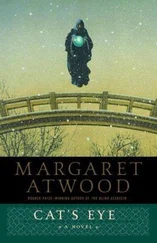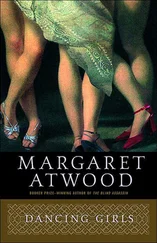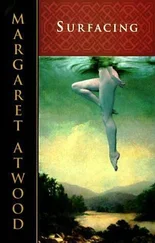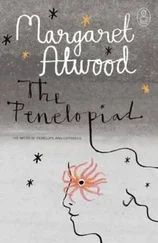Stick in hand, rehearsing the story he’ll tell them, he goes along the path to their encampment. They call this path the Snowman Fish Path, because they carry his fish along it every week. It skirts the edge of the beach while keeping to the shade; nevertheless he finds it too bright, and tilts his baseball cap down to keep out the rays. He whistles as he approaches them, as he always does to let them know he’s coming. He doesn’t want to startle them, strain their politeness, cross their boundaries without being invited—loom up on them suddenly out of the shrubbery, like some grotesque flasher exposing himself to schoolkids.
His whistle is like a leper’s bell: all those bothered by cripples can get out of his way. Not that he’s infectious: what he’s got they’ll never catch. They’re immune from him.
The men are performing their morning ritual, standing six feet apart in a long line curving off into the trees at either side. They’re facing outward as in pictures of muskoxen, pissing along the invisible line that marks their territory. Their expressions are grave, as befits the seriousness of their task. They remind Snowman of his father heading out the door in the morning, briefcase in hand, an earnest aiming-for-the-target frown between his eyes.
The men do this twice a day, as they’ve been taught: it’s necessary to keep the volume constant, the odour renewed. Crake’s model had been the canids and the mustelids, and a couple of other families and species as well. Scent-marking was a wide-ranging mammalian leitmotif, he’d said, nor was it confined to the mammals. Certain reptiles, various lizards…
“Never mind about the lizards,” said Jimmy.
According to Crake—and Snowman has seen nothing since to disprove it—the chemicals programmed into the men’s urine are effective against wolvogs and rakunks, and to a lesser extent against bobkittens and pigoons. The wolvogs and bobkittens are reacting to the scent of their own kind and must imagine a huge wolvog or bobkitten, from which they would be wise to keep their distance. The rakunks and pigoons imagine large predators. Or this was the theory.
Crake allotted the special piss to men only; he said they’d need something important to do, something that didn’t involve childbearing, so they wouldn’t feel left out. Woodworking, hunting, high finance, war, and golf would no longer be options, he’d joked.
There are some disadvantages to this plan, in action—the ring-of-pee boundary line smells like a rarely cleaned zoo—but the circle is large enough so that there’s ample smell-free room inside it. Anyway Snowman is used to it by now.
He waits politely for the men to finish. They don’t ask him to join them: they already know his piss is useless. Also it’s their habit to say nothing while performing their task: they need to concentrate, to make sure their urine lands in exactly the right place. Each has his own three feet of borderland, his own area of responsibility. It’s quite a sight: like the women, these men—smooth-skinned, well-muscled—look like statues, and grouped like this they resemble an entire Baroque fountain. A few mermaids and dolphins and cherubs and the scene would be complete. Into Snowman’s head comes the image of a circle of naked car mechanics, each holding a wrench. A whole squad of Mr. Fix-its. A gay magazine centrefold. Witnessing their synchronized routine, he almost expects them to break into some campy chorus line from one of the seedier nightclubs.
The men shake off, break their circle, look over at Snowman with their uniformly green eyes, smile. They’re always so goddamn affable.
“Welcome, oh Snowman,” says the one called Abraham Lincoln. “Will you join us inside our home?” He’s getting to be a bit of a leader, that one. Watch out for the leaders , Crake used to say. First the leaders an d the led, then the tyrants and the slaves, then the massacres. That’s how it’s always gone.
Snowman steps over the wet line on the ground, ambles along with the men. He’d just had a brilliant idea: what if he were to take some of the saturated earth with him on his journey, as a protective device? It might ward off the wolvogs. But on second thought, the men would find the gap dug in their defences and would know he’d done it. Such an act could be misinterpreted: he wouldn’t want to be suspected of weakening their fortress, exposing their young to danger.
He’ll have to cook up a new directive from Crake, present it to them later. Crake has told me you must collect an offering of your scent. Get them all to piss in a tin can. Sprinkle it around his tree. Make a fairy ring. Draw his own line in the sand.
They reach the open space at the centre of the territorial circle. Off to one side, three of the women and one man are tending to a little boy, who appears to be hurt in some way. These people are not immune from wounds—the children fall down or bash their heads on trees, the women burn their fingers tending the fires, there are cuts and scrapes—but so far the injuries have been minor, and easily cured by purring.
Crake had worked for years on the purring. Once he’d discovered that the cat family purred at the same frequency as the ultrasound used on bone fractures and skin lesions and were thus equipped with their own self-healing mechanism, he’d turned himself inside out in the attempt to install that feature. The trick was to get the hyoid apparatus modified and the voluntary nerve pathways connected and the neocortex control systems adapted without hampering the speech abilities. There’d been quite a few botched experiments, as Snowman recalled. One of the trial batch of kids had manifested a tendency to sprout long whiskers and scramble up the curtains; a couple of the others had vocal-expression impediments; one of them had been limited to nouns, verbs, and roaring.
Crake did it though, thinks Snowman. He pulled it off. Just look at the four of them now, heads down close to the child, purring away like car engines.
“What happened to him?” he asks.
“He was bitten,” says Abraham. “One of the Children of Oryx bit him.”
This is something new. “What kind?”
“A bobkitten. For no reason.”
“It was outside our circle, it was in the forest,” says one of the women—Eleanor Roosevelt? Empress Josephine?—Snowman can’t always remember their names.
“We were forced to hit it with rocks, to make it go away,” says Leonardo da Vinci, the man in the purring quartet.
So the bobkittens are hunting kiddies now, thinks Snowman. Maybe they’re getting hungry—as hungry as he is himself. But they have lots of rabbits to choose from, so it can’t be simple hunger. Maybe they see the Children of Crake, the little ones anyway, as just another kind of rabbit, though easier to catch.
“Tonight we will apologize to Oryx,” says one of the women—Sacajawea?—“for the rocks. And we will request her to tell her children not to bite us.”
He’s never seen the women do this—this communion with Oryx—although they refer to it frequently. What form does it take? They must perform some kind of prayer or invocation, since they can hardly believe that Oryx appears to them in person. Maybe they go into trances. Crake thought he’d done away with all that, eliminated what he called the G-spot in the brain. God is a cluster of neurons , he’d maintained. It had been a difficult problem, though: take out too much in that area and you got a zombie or a psychopath. But these people are neither.
They’re up to something though, something Crake didn’t anticipate: they’re conversing with the invisible, they’ve developed reverence. Good for them, thinks Snowman. He likes it when Crake is proved wrong. He hasn’t caught them making any graven images yet, however.
Читать дальше












